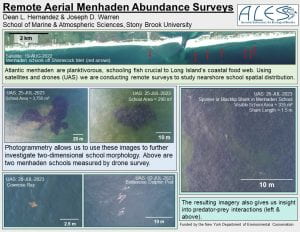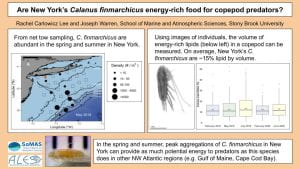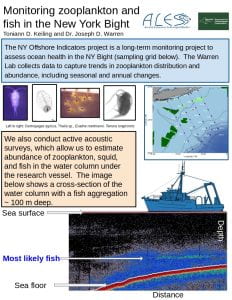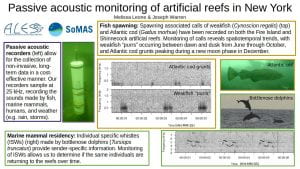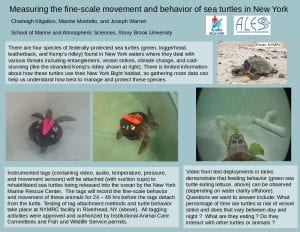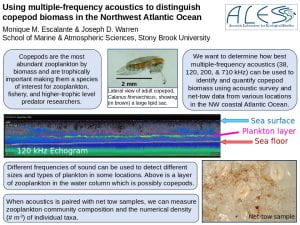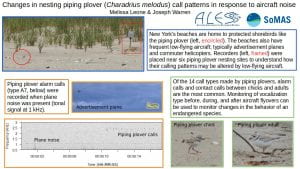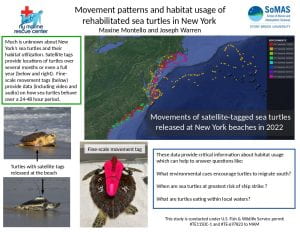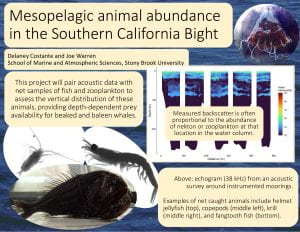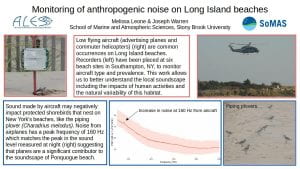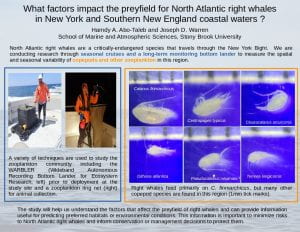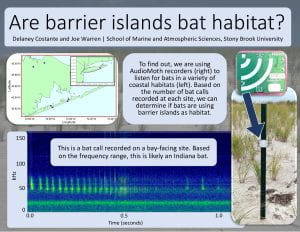Here are some one-page summaries (click to view full size) I had members of the lab put together on our current suite of research projects. More detailed information about themes/topics our group works on follow below the table.
Some of the themes / projects that my lab works on includes:
Predator and Prey Interactions
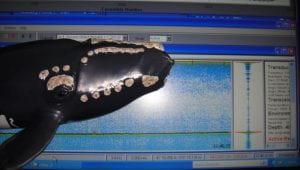 Understanding the foraging behavior of predators such as marine mammals, seabirds, and other top predators often requires knowledge about the distribution and abundance of their prey. By measuring the amount and location of fish and zooplankton using active acoustic echosounders, we can provide information necessary to interpret predator behavior. I’m particularly interested in these interactions at the fine-scale (in both space and time) so we are examining research questions like: How many fish (or krill) does a humpback whale capture when it takes a gulp — and how does this answer change when a whale feeds cooperatively or individually ? Do humpback whales change their preferred prey due to prey abundance and/or the prey’s ability to avoid predation (i.e. will a whale choose to feed on slower and easier to capture,but less energy rich prey) ? How do these predators detect their prey and what are the capabilities of these sensing systems. This research takes place all over the world including: blue whales in Chile, right whales in Cape Cod, and humpback whales in SE Coastal Alaska, Massachusetts, Australia, Antarctica, and even New York!
Understanding the foraging behavior of predators such as marine mammals, seabirds, and other top predators often requires knowledge about the distribution and abundance of their prey. By measuring the amount and location of fish and zooplankton using active acoustic echosounders, we can provide information necessary to interpret predator behavior. I’m particularly interested in these interactions at the fine-scale (in both space and time) so we are examining research questions like: How many fish (or krill) does a humpback whale capture when it takes a gulp — and how does this answer change when a whale feeds cooperatively or individually ? Do humpback whales change their preferred prey due to prey abundance and/or the prey’s ability to avoid predation (i.e. will a whale choose to feed on slower and easier to capture,but less energy rich prey) ? How do these predators detect their prey and what are the capabilities of these sensing systems. This research takes place all over the world including: blue whales in Chile, right whales in Cape Cod, and humpback whales in SE Coastal Alaska, Massachusetts, Australia, Antarctica, and even New York!
S.S. Urmy and J.D. Warren (2018) “Foraging hotspots of common and roseate terns: the influence of tidal currents, bathymetry, and prey density.” Marine Ecology Progress Series. 590: 227-245. doi:10.3354/meps12451
K. Owen, A. S. Kavanagh, J.D. Warren, M.J. Noad, D. Donnelly, A.W. Goldizen, R.A. Dunlop. 2016. Potential energy gain by whales outside fo the Antarctic: prey preferences and consumption rates of migrating humpback whales (Megaptera Novaeangliae). Polar Biology. doi:10.1007/s00300-016-1951-9
K. Owen, J.D. Warren, M.J. Noad, D. Donnelly, A.W. Goldizen, and R.A. Dunlop. (2015) The effect of prey type on the fine-scale feeding behaviour of migrating east Australian humpback whales. Marine Ecology Progress Series. 541: 231-244 doi:10.3354/meps11551
Improving Acoustic Estimates of Fish and Zooplankton Abundance

We use a combination of computer-based scattering models, tank-based experiments, and field-surveys of aggregations of fish and zooplankton to collect information on how individual animals scatter sound at different frequencies and how animal behavior and their physical properties may change that. Many fish stock populations are assessed acoustically and improving the accuracy of those estimates is important for better managing the fisheries and the overall ecosystem. We work on a variety of different habitats ranging from the coastal waters of New York to the Bering Sea and other Pacific Ocean habitats.
B.M. Lucca and J.D. Warren. (2019) “Fishery-independent observations of Atlantic menhaden abundance in the coastal waters south of New York” Fisheries Research 218: 229-236. doi:10.1016/j.fishres.2019.05.016
B.M. Lucca and J.D. Warren. (2018) “Acoustically-measured distribution and abundance of Atlantic menhaden (Brevoortia tyrannus) in a shallow estuary in Long Island, NY” Estuaries and Coasts. doi:10.1007/s12237-018-0367-x
Deep Sea Mesopelagic Habitats
 We use active acoustics and net tows to examine the mesopelagic ecosystem (a.k.a. The Twilight Zone) through a variety of projects and consortiums including: ADEON, DEEPEND, and DEEP SEARCH. We examine how the deep scattering layers can be remotely assessed which is an important topic for researchers studying pelagic ecology, trophic interactions, and the global carbon budget. And we get to find some amazingly cool animals when we do our net tows!
We use active acoustics and net tows to examine the mesopelagic ecosystem (a.k.a. The Twilight Zone) through a variety of projects and consortiums including: ADEON, DEEPEND, and DEEP SEARCH. We examine how the deep scattering layers can be remotely assessed which is an important topic for researchers studying pelagic ecology, trophic interactions, and the global carbon budget. And we get to find some amazingly cool animals when we do our net tows!
 M. D’elia, J.D. Warren, I. Rodriguez-Pinto, T.T. Sutton, A. Cook, K.M. Boswell. 2016. Diel variation in the vertical distribution of deep-water scattering layers in the Gulf of Mexico. Deep-Sea Research I. 115:91-102. doi:10.1016/j.dsr.2016.05.014
M. D’elia, J.D. Warren, I. Rodriguez-Pinto, T.T. Sutton, A. Cook, K.M. Boswell. 2016. Diel variation in the vertical distribution of deep-water scattering layers in the Gulf of Mexico. Deep-Sea Research I. 115:91-102. doi:10.1016/j.dsr.2016.05.014
Passive Acoustic Monitoring of Coastal Organisms and Habitats
 We are using passive acoustics to monitor and measure the behavior of a variety of different marine organisms in coastal environments here in Long Island and in Jamaica. By identifying and describing the characteristic noises that different animals make (through laboratory and field measurements), we can collect long-term data sets and examine the activity and behavior of these animals and how their behavior varies due to biological (e.g. predation) or environmental (e.g. increasing noise) factors. Did you know that a bay scallop “cough” is a distinct sound underwater ?
We are using passive acoustics to monitor and measure the behavior of a variety of different marine organisms in coastal environments here in Long Island and in Jamaica. By identifying and describing the characteristic noises that different animals make (through laboratory and field measurements), we can collect long-term data sets and examine the activity and behavior of these animals and how their behavior varies due to biological (e.g. predation) or environmental (e.g. increasing noise) factors. Did you know that a bay scallop “cough” is a distinct sound underwater ?
C. Wirth and J.D. Warren. (2019) “Overlapping use of an artificial reef by humans and an apex predator (Tursiops truncatus) in the New York Bight.” Marine Mammal Science 35(1): 271-283. doi:10.1111/mms.12515 [first published online: May 2018]
C. Wirth and J.D. Warren. (2018) “Spatial and temporal variation in toadfish (Opsanus tau) and cusk eel (Ophidion marginatum) mating choruses in eelgrass (Zostera marina) beds in a shallow, temperate estuary.” Bioacoustics. doi: 10.1080/09524622.2018.1542631
Great Gull Island Radar Research
 This project was created and led by former graduate student Sam Urmy.
This project was created and led by former graduate student Sam Urmy.
Great Gull Island, located in eastern Long Island Sound, is one of the largest breeding colonies on the East Coast for common and roseate terns. Arriving from South America in the late spring, these small seabirds mate, lay eggs, and raise their young from hatching to fledging in a few short months at the height of the summer before departing again for their wintering grounds in the Southern Hemisphere. All of this is requires a lot of food, which for the terns means small baitfish like sand eels. This food, however, tends to occur in small, dense, unpredictable patches.
S.S. Urmy and J.D. Warren (2018) “Foraging hotspots of common and roseate terns: the influence of tidal currents, bathymetry, and prey density.” Marine Ecology Progress Series. 590: 227-245. doi:10.3354/meps12451
Urmy and Warren (2016) Quantitative ornithology with a commercial marine radar: standard-target calibration, target detection and tracking, and measurement of echoes from individuals and flocks. Methods in Ecology and Evolution. doi:10.1111/2041-210X.12699 [.pdf]
Effects of Forest Fires on Aquatic Ecosystems
 As part of an NSF-sponsored RAPID project with collaborators at Miami University (Ohio) and UC Davis (and their TERC research center), we are conducting acoustic surveys of lakes in the Sierra Nevada mountains which are in the watershed or airshed of large forest fires (specifically the 2013 Rimfire near Yosemite National Park and the 2014 King fire near Lake Tahoe). We are interested in how the smoke, ash, and runoff from these large fires affects the air and water clarity in nearby lakes, which in turn will affect the behavior and distribution of zooplankton in these ecosystems. The nature of this project has required some short-notice travel on our part to sample lakes while the fires are happening.
As part of an NSF-sponsored RAPID project with collaborators at Miami University (Ohio) and UC Davis (and their TERC research center), we are conducting acoustic surveys of lakes in the Sierra Nevada mountains which are in the watershed or airshed of large forest fires (specifically the 2013 Rimfire near Yosemite National Park and the 2014 King fire near Lake Tahoe). We are interested in how the smoke, ash, and runoff from these large fires affects the air and water clarity in nearby lakes, which in turn will affect the behavior and distribution of zooplankton in these ecosystems. The nature of this project has required some short-notice travel on our part to sample lakes while the fires are happening.
S.S. Urmy and J.D. Warren (2019) “Seasonal changes in the biomass, distribution, and patchiness of zooplankton and fish in four lakes in the Sierra Nevada, California.” Freshwater Biology. doi:10.1111/fwb.13362
Urmy et al. (2016) Vertical redistribution of zooplankton in an oligotrophic lake associated with reduction in ultraviolet radiation by wildfire smoke. Geophysical Research Letters. doi:10.1002/2016GL068533 [.pdf]
Williamson et al. (2016) Sentinel responses to droughts, wildfires, and floods: Ultraviolet radiation and the consequences for lakes and their ecosystem services. Frontiers in Ecology and Environment. 14(2): 102-109. doi:10.1002/fee.1228 [.pdf]
Artificial Reef Fish Surveys
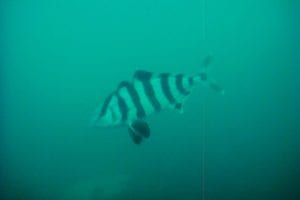 The state of NY has constructed numerous artificial reefs (composed of rock, barges, or in one case 10 Good Humor Ice Cream trucks) off the southern coast of Long Island. Working with my Stony Brook colleagues (Professors Peterson and Chapman), we are surveying these reefs to examine fish and invertebrate utilization and explore how the size, material, and age of the reef contributes to the overall biological productivity of these sites. Our focus is on acoustic echosounder and sidescan surveys of these reefs to assess near-bottom and pelagic fish abundance.
The state of NY has constructed numerous artificial reefs (composed of rock, barges, or in one case 10 Good Humor Ice Cream trucks) off the southern coast of Long Island. Working with my Stony Brook colleagues (Professors Peterson and Chapman), we are surveying these reefs to examine fish and invertebrate utilization and explore how the size, material, and age of the reef contributes to the overall biological productivity of these sites. Our focus is on acoustic echosounder and sidescan surveys of these reefs to assess near-bottom and pelagic fish abundance.
Zooplankton Ecology in Freshwater Lakes
 Working with collaborators from Miami University (Ohio), we have conducted several acoustic surveys of the zooplankton populations in several freshwater lakes in the Poconos in Pennsylvania. Using human (ok, grad student)-powered rowboats, we are investigating ecological questions such as the role fish predation and UV tolerance/avoidance play in affecting the vertical distribution of freshwater zooplankton. We are also working on a estimating the total zooplankton biomass of these lakes using acoustic and net tow sampling methods.
Working with collaborators from Miami University (Ohio), we have conducted several acoustic surveys of the zooplankton populations in several freshwater lakes in the Poconos in Pennsylvania. Using human (ok, grad student)-powered rowboats, we are investigating ecological questions such as the role fish predation and UV tolerance/avoidance play in affecting the vertical distribution of freshwater zooplankton. We are also working on a estimating the total zooplankton biomass of these lakes using acoustic and net tow sampling methods.
Warren et al. (2016). Measuring the distribution, abundance, and biovolume of zooplankton in an oligotrophic freshwater lake with a 710 kHz scientific echosounder. Limnology & Oceanography: Methods. doi:10.1002/lom3.10084 [.pdf]
HUDSONAR – Hudson River Echosounder Surveys
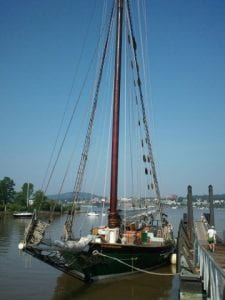
We installed a two frequency scientific echosounder on the hull of the SV Clearwater, a replica of a 19th century Dutch sloop which travels up and down the Hudson River from the waters of New York City all the way up to Albany. Its mission is maritime history, marine science, and environmental education. The data that the Clearwater collects will provide us insight about the fish and zooplankton and how their distribution and abundance vary spatially and temporally. This project is a joint effort of my lab, the SV Clearwater, and the Hudson River Foundation
Acoustic scattering from hake and Humboldt squid in the Pacific Ocean
 In conjunction with collaborators at Oregon State University and the National Marine Fisheries Service, we are conducting a study on the acoustic scattering properties of hake (a commercially-fished species) and Humboldt squid (a recent immigrant) along the Pacific coast of Washington, Oregon, and California. Using lab, dock-side, and ship-based experiments and surveys, we hope to improve our ability to assess the distribution and abundance of these pelagic organisms as well as determine the scattering mechanisms and properties of these animals.
In conjunction with collaborators at Oregon State University and the National Marine Fisheries Service, we are conducting a study on the acoustic scattering properties of hake (a commercially-fished species) and Humboldt squid (a recent immigrant) along the Pacific coast of Washington, Oregon, and California. Using lab, dock-side, and ship-based experiments and surveys, we hope to improve our ability to assess the distribution and abundance of these pelagic organisms as well as determine the scattering mechanisms and properties of these animals.
K.N. Becker and J.D. Warren. 2015. Material properties of Pacific hake, Humboldt squid, and two species of myctophids in the California Current. Journal of the Acoustical Society of America. 137(5): 2522-2532. doi: 10.1121/1.4919308.
K.N. Becker and J.D. Warren. 2014. Material properties of Northeast Pacific zooplankton. ICES Journal of Marine Science. 71(9): 2550-2563. doi: 10.1093/icesjms/fsu109
Effect of zooplankton on the behavior of marine mammals in Massachusetts and Antarctica.
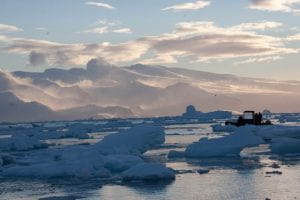
In conjunction with collaborators at Penn State and the Provincetown Center for Coastal Studies, we are measuring the distribution and abundance of zooplankton populations in Cape Cod Bay and Stellwagen Bank National Marine Sanctuary.
Our net tow, acoustic backscatter, and hydrographic data will be combined with data from scientists who are monitoring the behavior of right and humpback whales in these waters. We are examining what role zooplankton prey play in determining marine mammal behavior. We are also working with a group of researchers at Duke University on studying the role that Antarctic krill play on the behavior of Humpback whales in Antarctica. We participated in the MISHAP X cruise in May and June 2010 and are currently analyzing data from this project.
Distribution, abundance, and scattering characteristics of Antarctic salps.
 Over two field seasons in 2010 and 2011, we travelled to Antarctica and conducted surveys and experiments on salps (Salpa thompsoni primarily). These gelatinous animals occur in great abundances (or blooms) in this region and can be very important in terms of oceanic carbon transport. In addition, they compete with Antarctic krill for the title of dominant zooplankton which can have important effects on the other animals in this region (whales, seals, penguins and other sea birds) who rely on krill as their primary food source.
Over two field seasons in 2010 and 2011, we travelled to Antarctica and conducted surveys and experiments on salps (Salpa thompsoni primarily). These gelatinous animals occur in great abundances (or blooms) in this region and can be very important in terms of oceanic carbon transport. In addition, they compete with Antarctic krill for the title of dominant zooplankton which can have important effects on the other animals in this region (whales, seals, penguins and other sea birds) who rely on krill as their primary food source.
Remote assessment of zooplankton, nekton, underwater noise and animal vocalizations.
 We are working with researchers at Penn State University and the University of Washington on the analysis of data from moorings equipped with oceanographic and both passive and active acoustics sensors that have been deployed in the Bering Sea and in the Northwest Atlantic. Data from these sensors allows us to estimate the primary production and physical oceanographic environment, presence of sea ice, presence and abundance of zooplankton and small nekton (from the active acoustic system) and marine mammals (from the passive acoustic system). These data are important to understand how ecosystem dynamics are changing in the Bering Sea as the extent and duration of winter sea ice diminishes. In the Northwest Atlantic, we are using these data to assess prey availability in connection with the behavior of marine mammal predators.
We are working with researchers at Penn State University and the University of Washington on the analysis of data from moorings equipped with oceanographic and both passive and active acoustics sensors that have been deployed in the Bering Sea and in the Northwest Atlantic. Data from these sensors allows us to estimate the primary production and physical oceanographic environment, presence of sea ice, presence and abundance of zooplankton and small nekton (from the active acoustic system) and marine mammals (from the passive acoustic system). These data are important to understand how ecosystem dynamics are changing in the Bering Sea as the extent and duration of winter sea ice diminishes. In the Northwest Atlantic, we are using these data to assess prey availability in connection with the behavior of marine mammal predators.
Modeling the Target Strength of Bering Sea Euphausiids
 The walleye pollock fishery is the largest United States fishery (in terms of landings) and is annually studied by the NMFS Alaska Fisheries Science Center MACE program through regular cruises in the Bering Sea. To assess the stock of pollock, the fishery scientists use a combination of acoustic echosounder surveys and net trawls. We are working with them to develop an improved model of the scattering characteristics of the zooplankton of the Bering Sea, in particular the euphausiids. Aggregations of these animals scatter sound and can be confused with the scattering from pollock schools. We collected and measured a variety of Bering Sea zooplankton and are developing mathematical models that describe their acoustic scattering so that the fishery scientists can better identify scatterers as pollock or other biological organisms.
The walleye pollock fishery is the largest United States fishery (in terms of landings) and is annually studied by the NMFS Alaska Fisheries Science Center MACE program through regular cruises in the Bering Sea. To assess the stock of pollock, the fishery scientists use a combination of acoustic echosounder surveys and net trawls. We are working with them to develop an improved model of the scattering characteristics of the zooplankton of the Bering Sea, in particular the euphausiids. Aggregations of these animals scatter sound and can be confused with the scattering from pollock schools. We collected and measured a variety of Bering Sea zooplankton and are developing mathematical models that describe their acoustic scattering so that the fishery scientists can better identify scatterers as pollock or other biological organisms.
The Nearshore Antarctic Krill Ecosystem
 Using a variety of platforms (large research vessel, small boat, and instrumented buoys), my co-PI David Demer (SWFSC, NOAA) and I are trying to understand the biological and physical factors that create regions of high krill productivity in the nearshore waters off of Livingston Island, Antarctica. These areas serve as the main foraging grounds for resident penguin and fur seal populations and understanding the spatial and temporal variability of the krill distribution is important to understand how the ecosystem functions. Additionally, I’m working with other scientists who study krill predators in this area to understand how the distribution of prey (krill) is related to predator foraging range and behavior. This project is supported by the National Science Foundation and NOAA.
Using a variety of platforms (large research vessel, small boat, and instrumented buoys), my co-PI David Demer (SWFSC, NOAA) and I are trying to understand the biological and physical factors that create regions of high krill productivity in the nearshore waters off of Livingston Island, Antarctica. These areas serve as the main foraging grounds for resident penguin and fur seal populations and understanding the spatial and temporal variability of the krill distribution is important to understand how the ecosystem functions. Additionally, I’m working with other scientists who study krill predators in this area to understand how the distribution of prey (krill) is related to predator foraging range and behavior. This project is supported by the National Science Foundation and NOAA.
SCERP and Long Island South Shore Estuary System
 Understanding the local waters of Long Island in terms of the biological and physical oceanography is important for a variety of reasons, including shellfish and finfish stocks, anthropogenic influences, effect of development, and management of recreational areas. Studies have been undertaken by several researchers investigating many different aspects of the local estuarine environment. Our group has investigated the influence that the ocean inlets along the south shore of Long Island have on the temperature and salinity distributions within the bays. Both tidal and wind-driven circulation are the primary factors controlling the levels of salinity and temperature within the bays which are critical factors affecting shellfish habitat, recruitment, and growth. This project is supported by New York Sea Grant and the SCERP foundation.
Understanding the local waters of Long Island in terms of the biological and physical oceanography is important for a variety of reasons, including shellfish and finfish stocks, anthropogenic influences, effect of development, and management of recreational areas. Studies have been undertaken by several researchers investigating many different aspects of the local estuarine environment. Our group has investigated the influence that the ocean inlets along the south shore of Long Island have on the temperature and salinity distributions within the bays. Both tidal and wind-driven circulation are the primary factors controlling the levels of salinity and temperature within the bays which are critical factors affecting shellfish habitat, recruitment, and growth. This project is supported by New York Sea Grant and the SCERP foundation.

